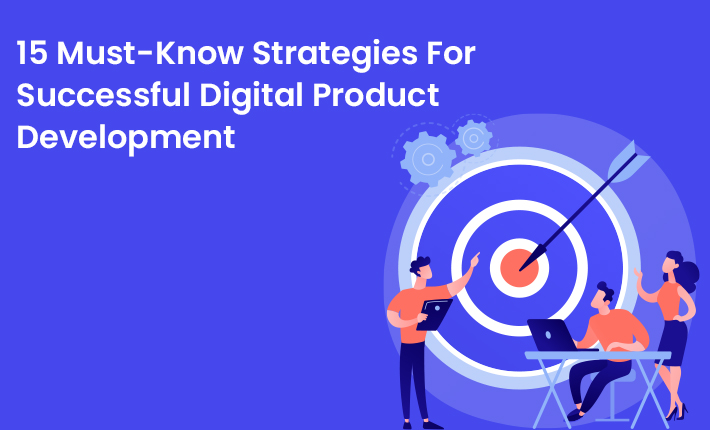In today's rapidly evolving digital landscape, the success of a product hinges on effective digital product development strategies. With customers demanding seamless user experiences and innovative solutions, businesses must stay ahead of the curve to remain competitive. In this article, we will explore 15 must-know strategies for achieving success in digital product development.
Define Clear Goals and Objectives:
Before embarking on any digital product development journey, it is crucial to define clear goals and objectives. This involves understanding the problem you aim to solve, identifying your target audience, and outlining specific success metrics. By establishing a clear direction from the outset, you can align your efforts and make informed decisions throughout the development process.
Conduct Thorough Market Research:
Market research plays a pivotal role in digital product development. By gaining a deep understanding of your target market, including their needs, preferences, and pain points, you can design a product that resonates with them. Conducting user surveys, competitor analysis, and market trend research will provide invaluable insights to inform your product strategy.
Emphasize User-Centric Design:
User-centric design is a fundamental aspect of successful digital product development. By placing your users at the center of the design process, you can create intuitive and engaging experiences. Conduct user testing and gather feedback at various stages of development to refine your product and ensure it meets the needs of your target audience.
Adopt an Agile Development Methodology:
Agile development methodologies, such as Scrum or Kanban, promote iterative and incremental development. This approach allows for flexibility, adaptability, and quick responses to changes in market demands. By breaking down the development process into manageable sprints, you can continuously improve your product while delivering value to your users.
Foster Cross-Functional Collaboration:
Successful digital product development requires effective collaboration between various teams and stakeholders. Encourage cross-functional collaboration between designers, developers, marketers, and product managers. By fostering open communication and knowledge sharing, you can leverage the diverse expertise of your team to create innovative solutions.
Prioritize Continuous Testing and Feedback:
Testing and feedback loops are essential components of successful digital product development. Implement continuous testing throughout the development process to identify and address any issues or bugs promptly. Additionally, gather feedback from users and stakeholders to validate assumptions, improve usability, and refine your product's features.
Leverage Data-Driven Insights:
Data-driven insights provide invaluable guidance in digital product development. Utilize analytics tools to track user behavior, engagement, and conversion rates. Analyze this data to identify areas for improvement, optimize user experiences, and make informed decisions about future iterations and enhancements.
Remain Agile in Response to Change:
The digital landscape is constantly evolving, and successful product development requires adaptability. Embrace change and remain agile in your approach. Continuously evaluate market trends, user feedback, and technological advancements to ensure your product stays relevant and competitive.
Invest in Continuous Learning and Skill Development:
Digital product development is a dynamic field, and staying ahead requires continuous learning and skill development. Encourage your team to pursue professional development opportunities, attend industry conferences, and stay updated with the latest trends and best practices. This investment in skill enhancement will empower your team to deliver high-quality products.
Iterate and Evolve:
Digital product development is not a one-time event; it is an ongoing process. Embrace a mindset of continuous improvement, iteration, and evolution. Gather insights from user feedback, measure the success of your product against predefined metrics, and iterate based on the results. By consistently refining and enhancing your product, you can deliver exceptional experiences and stay ahead of the competition.
Stay Updated with Emerging Technologies:
To stay ahead in the digital product development landscape, it is crucial to stay updated with emerging technologies. Keep a close eye on advancements in areas such as artificial intelligence, machine learning, blockchain, and virtual reality. By understanding and leveraging these technologies, you can introduce innovative features and capabilities to your product, enhancing its value proposition.
Foster a Culture of Innovation:
Creating a culture of innovation within your organization is key to successful digital product development. Encourage creativity, experimentation, and out-of-the-box thinking among your team members. Provide them with the freedom to explore new ideas and take calculated risks. This culture of innovation will drive the development of unique and groundbreaking products.
Prioritize Scalability and Flexibility:
In the digital realm, scalability and flexibility are vital attributes for successful product development. Anticipate future growth and design your product with scalability in mind. Ensure that your architecture and infrastructure can handle increased user demands and accommodate future feature expansions. Additionally, prioritize flexibility to adapt your product to evolving market needs and customer expectations.
Develop a Robust Quality Assurance Process:
Quality assurance is paramount in digital product development. Implement a robust QA process to ensure that your product meets high standards of functionality, usability, and reliability. Conduct thorough testing across various devices, platforms, and user scenarios. Incorporate automated testing frameworks to streamline the QA process and detect issues early on.
Embrace Continuous Improvement and Feedback Loop:
Digital product development is an iterative process, and continuous improvement is essential for sustained success. Establish a feedback loop with your users, gathering their input and insights even after the product's launch. Actively listen to their suggestions, analyze their behavior, and incorporate their feedback into future updates. This approach demonstrates your commitment to delivering an exceptional user experience and helps you stay attuned to evolving user needs.
Conclusion:
By implementing these 15, including staying updated with emerging technologies, fostering a culture of innovation, prioritizing scalability and flexibility, developing a robust QA process, and embracing continuous improvement, you can enhance your chances of achieving success in digital product development. Remember, the digital landscape is ever-evolving, and a proactive and adaptable approach is key to creating products that meet the demands of the market and delight your users.

















Post Comments